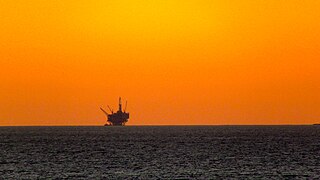
An oil platform, offshore platform, or offshore drilling rig is a large structure with facilities for well drilling to explore, extract, store, and process petroleum and natural gas which lies in rock formations beneath the seabed. Many oil platforms will also contain facilities to accommodate their workforce.

San Diego International Airport, formerly known as Lindbergh Field, is an international airport 3 mi (4.8 km) northwest of Downtown San Diego, California, United States. It is owned and operated by the San Diego County Regional Airport Authority. San Diego International Airport covers 663 acres of land.

A dock is the area of water between or next to one or a group of human-made structures that are involved in the handling of boats or ships or such structures themselves. The exact meaning varies among different variants of the English language.
A vactrain is a proposed design for very-high-speed rail transportation. It is a maglev line using partly evacuated tubes or tunnels. Reduced air resistance could permit vactrains to travel at very high (Hypersonic) speeds with relatively little power—up to 6,400–8,000 km/h (4,000–5,000 mph). This is 5–6 times the speed of sound in Earth's atmosphere at sea level. Vactrains might use gravity to assist their acceleration, as in a gravity train. If these trains achieve the predicted speeds, they could surpass aircraft as the world's fastest mode of public transportation.

A ballast tank is a compartment within a boat, ship or other floating structure that holds water, which is used as ballast to provide stability for a vessel. Using water in a tank provides easier weight adjustment than the stone or iron ballast used in older vessels. It also makes it easy for the crew to reduce a vessel's draft when they enter shallower water, by temporarily pumping out ballast. Airships use ballast tanks for similar advantages.

Port security is part of a broader definition concerning maritime security.It refers to the defense, law and treaty enforcement, and counterterrorism activities that fall within the port and maritime domain. It includes the protection of the seaports themselves and the protection and inspection of the cargo moving through the ports. Security risks related to ports often focus on either the physical security of the port, or security risks within the maritime supply chain.

Mobile offshore base (MOB), sometimes called a joint mobile offshore base (JMOB), is a concept for supporting military operations beyond the home shores, where conventional land bases are not available, by deploying on the high seas or in coastal waters, in-theater multipurpose floating base assembled from individual platforms. In essence, a MOB is a multipurpose modular self-propelled floating platform, or several interconnected platforms, that can perform multiple functions of a sea base including strike, deployment and logistics. An ocean-wise semi-submersible wave and wind resistant platform capable to move at one-half the speed of conventional prepositioning monohull cargo ship has been researched and proposed, but never built.

In boating, a fender is a bumper used to absorb the kinetic energy of a boat or vessel berthing against a jetty, quay wall or other vessel. Fenders, used on all types of vessels, from cargo ships to cruise ships, ferries and personal yachts, prevent damage to vessels and berthing structures. To do this, fenders have high energy absorption and low reaction force. Fenders are typically manufactured out of rubber, foam elastomer or plastic. Rubber fenders are either extruded or made in a mold. The type of fender that is most suitable for an application depends on many variables, including dimensions and displacement of the vessel, maximum allowable stand-off, berthing structure, tidal variations and other berth-specific conditions. The size of the fender unit is based on the berthing energy of the vessel which is related to the square of the berthing velocity.
Rewas(Rewas-Bodani or Revas) is one of 48 “minor” ports of Maharashtra located at Rewas Creek, near Karanja creek at mouth of the Patalganga River about 10 kilometres (6 mi) southward of Jawaharlal Nehru Port (JNPT) and 16 kilometres (9.9 mi) south-east of Mumbai Port. It is controlled by the state government through an agency known as the “Maharashtra Maritime Board”.
Seasteading is the concept of creating permanent dwellings at sea, called seasteads, outside the territory claimed by any government. The term is a combination of the words sea and homesteading.

U.S. Coast Guard Air Station San Diego is a Coast Guard Air Station based in San Diego, California, United States, across the street from San Diego International Airport. CGAS San Diego operates three MH-60T Jayhawk helicopters off the Coast Guard ramp.

Tensairity is a light weight structural concept that uses low pressure air to stabilize compression elements against buckling. It employs an ancient foundational splinting structure using inflated airbeams and attached stiffeners or cables that gains mechanical advantages for low mass. Pneumatic structures using tensairity are solving problems. The structure modality has been particularly developed by Mauro Pedretti.

A floating wind turbine is an offshore wind turbine mounted on a floating structure that allows the turbine to generate electricity in water depths where fixed-foundation turbines are not feasible. Floating wind farms have the potential to significantly increase the sea area available for offshore wind farms, especially in countries with limited shallow waters, such as Japan. Locating wind farms further offshore can also reduce visual pollution, provide better accommodation for fishing and shipping lanes, and reach stronger and more consistent winds.
Donald Alywn Innis,, is an American architect based in San Diego, California. Innis is also an inventor and engineer and has pioneered the idea of floating real estate, specifically the notion of a floating airport using pneumatic stabilized platform (PSP) technology which he has developed and patented through his company, Float Incorporated. Innis designed several notable San Diego landmarks, including the 1970s remodeling of the San Diego Broadway Pier, the master plan for the San Diego Embarcadero, and Terminal One of the San Diego International airport. He is a long-standing member of the American Institute of Architects.
The Atlantic Nuclear Power Plant was a proposed floating nuclear power plant located off the coast of New Jersey. It was proposed in the 1970s by the Public Service Electric and Gas Company. Two Westinghouse 1,150 MWe (net) pressurized water reactors were ordered in 1972, and another two Westinghouse 1,150 MWe (net) reactors were ordered in 1973. The four unit power plant proposal was canceled in 1978.

A flexible barge is a fabric barge (non-rigid) for the transportation of bulk fresh water or other liquid bulk items such as chemicals or oil.
Also known as the SAFE Foundation System, developed by architect and inventor Greg Henderson and his team at Arx Pax Labs, Inc., is a way to build in flood zones and coastal areas. It is designed to float buildings, roadways, and utilities in a few feet of water. The self-adjusting floating environment draws from existing technologies used to float concrete bridges and runways such as Washington’s SR 520 and Japan’s Mega-Float. It also absorbs the shock of earthquakes, allowing buildings and their related communities to remain stable. Arx Pax is working with Republic of Kiribati and Pacific Rising to solve for sustainable development challenges associated with rising sea levels.













